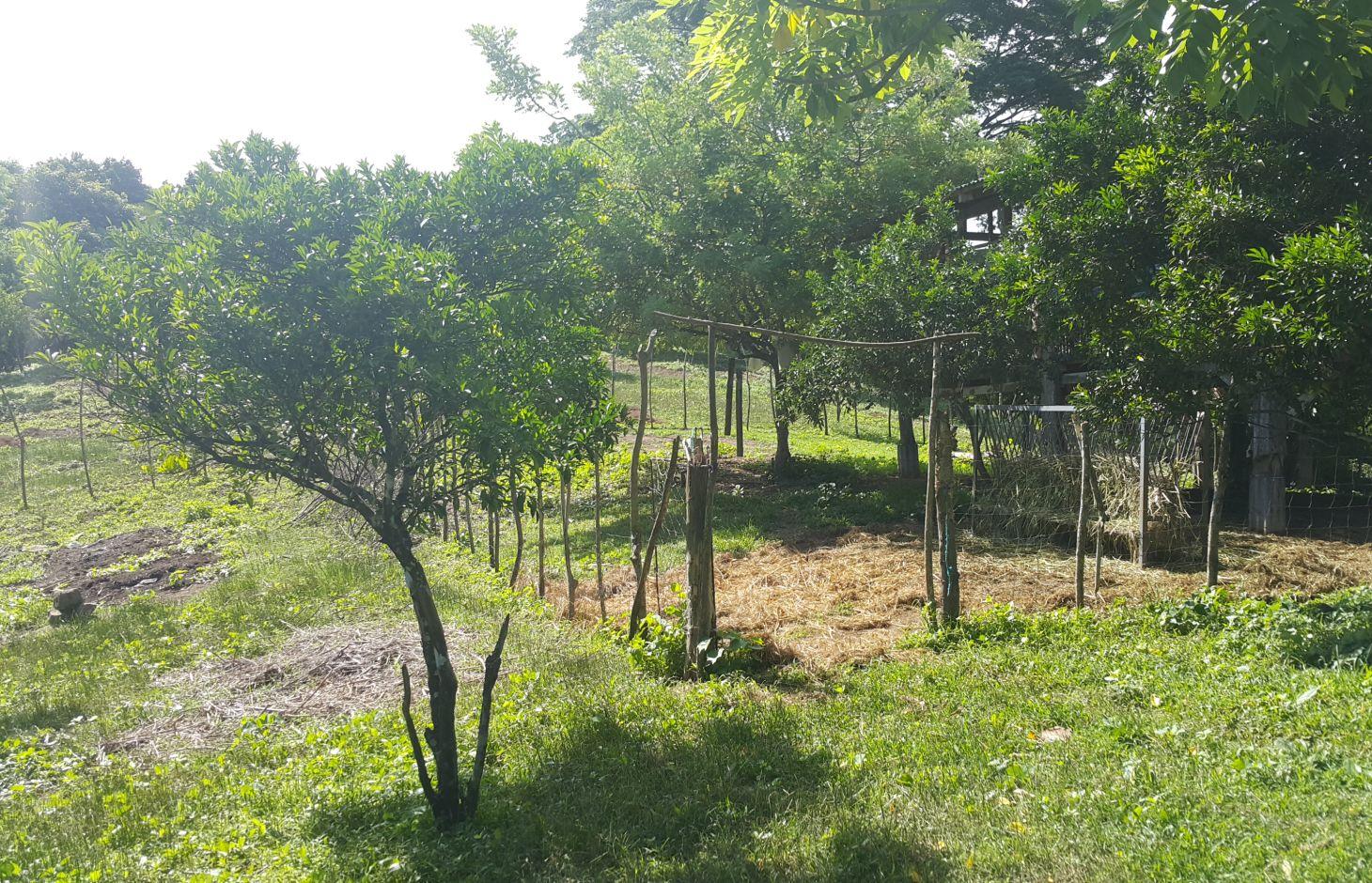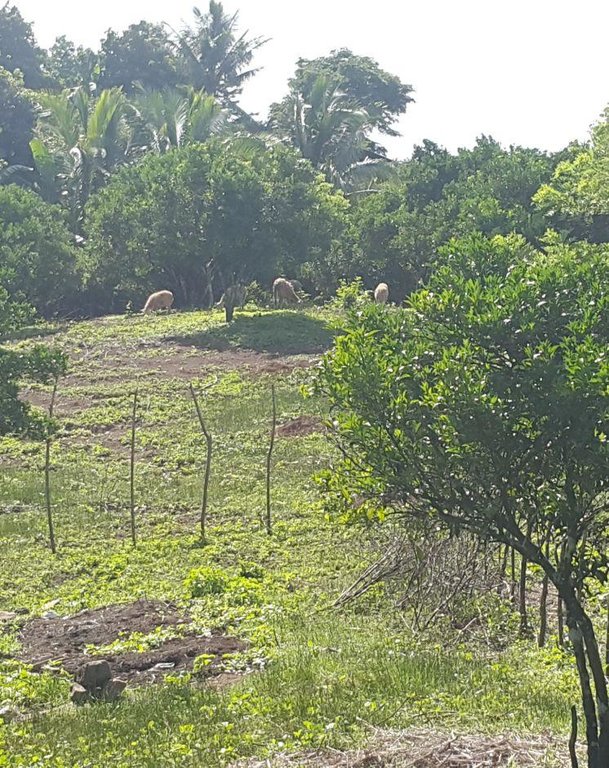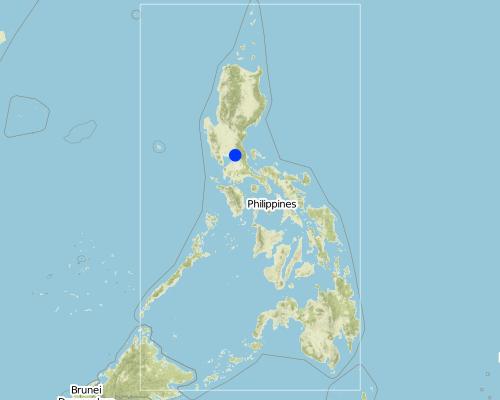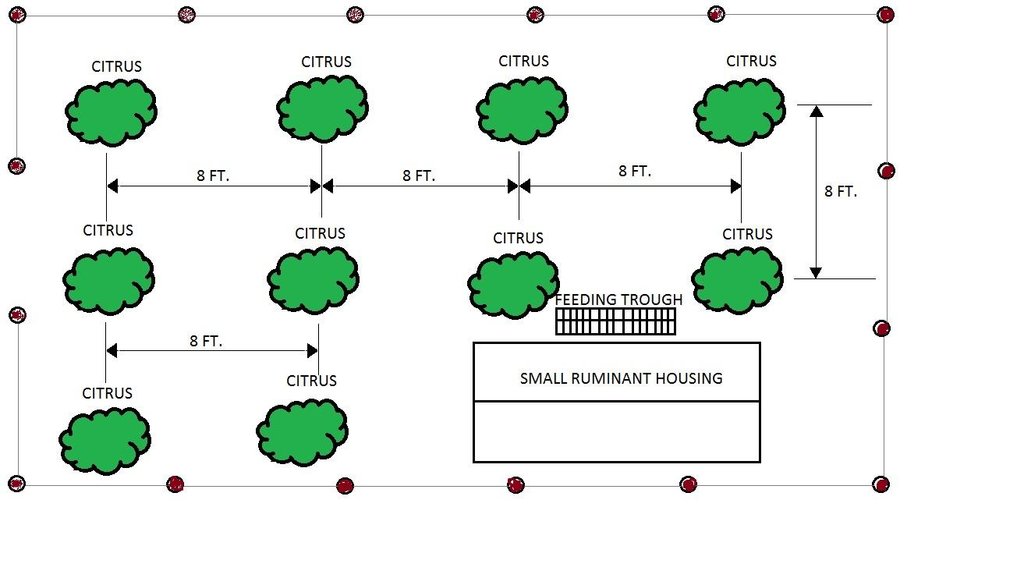Improved pasture under citrus [ប្រទេសហ្វីលីពីន]
- ការបង្កើត៖
- បច្ចុប្បន្នភាព
- អ្នកចងក្រង៖ Philippine Overview of Conservation Approaches and Technologies
- អ្នកកែសម្រួល៖ –
- អ្នកត្រួតពិនិត្យ Fabian Ottiger
Pastulan sa ilalim ng dalanghitaan (Filipino)
technologies_1321 - ប្រទេសហ្វីលីពីន
ពិនិត្យមើលគ្រប់ផ្នែក
ពង្រីកមើលទាំងអស់ បង្រួមទាំងអស់1. ព័ត៌មានទូទៅ
1.2 ព័ត៌មានលម្អិតពីបុគ្គលសំខាន់ៗ និងស្ថាប័នដែលចូលរួមក្នុងការវាយតម្លៃ និងចងក្រងឯកសារនៃបច្ចេកទេស
បុគ្គលសំខាន់ម្នាក់ (ច្រើននាក់)
អ្នកជំនាញឯកទេស SLM:
Rojales Jose
(632)9230459
Departement of Agriculture - Bureau of Soils and Water Management
Quezon City Elliptical Road corner Visayas Avenue, Diliman, Quezon City
ប្រទេសហ្វីលីពីន
អ្នកជំនាញឯកទេស SLM:
Calonge Arsenio
(632)9230459
Departement of Agriculture - Bureau of Soils and Water Management
Quezon City Elliptical Road corner Visayas Avenue, Diliman, Quezon City
ប្រទេសហ្វីលីពីន
អ្នកជំនាញឯកទេស SLM:
Millare Kirby
(632)9230459
Departement of Agriculture - Bureau of Soils and Water Management
Quezon City Elliptical Road corner Visayas Avenue, Diliman, Quezon City
ប្រទេសហ្វីលីពីន
អ្នកជំនាញឯកទេស SLM:
Quinto Jasmin
(632)9230459
Departement of Agriculture - Bureau of Soils and Water Management
Quezon City Elliptical Road corner Visayas Avenue, Diliman, Quezon City
ប្រទេសហ្វីលីពីន
អ្នកជំនាញឯកទេស SLM:
Gultiano Wilfredo
(632)9230459
Departement of Agriculture - Bureau of Soils and Water Management
Quezon City Elliptical Road corner Visayas Avenue, Diliman, Quezon City
ប្រទេសហ្វីលីពីន
អ្នកជំនាញឯកទេស SLM:
Cornes Jennelyn Mae
(632)9230459
Departement of Agriculture - Bureau of Soils and Water Management
Quezon City Elliptical Road corner Visayas Avenue, Diliman, Quezon City
ប្រទេសហ្វីលីពីន
អ្នកជំនាញឯកទេស SLM:
ឈ្មោះអង្គភាពមួយ (ច្រើន) ដែលបានចងក្រងឯកសារ/ វាយតម្លៃបច្ចេកទេស (បើទាក់ទង)
Bureau of Soils and Water Management (Bureau of Soils and Water Management) - ប្រទេសហ្វីលីពីន1.3 លក្ខខណ្ឌទាក់ទងទៅនឹងការប្រើប្រាស់ទិន្នន័យដែលបានចងក្រងតាមរយៈ វ៉ូខេត
តើពេលណាដែលទិន្នន័យបានចងក្រង (នៅទីវាល)?
29/06/2016
អ្នកចងក្រង និង(បុគ្គលសំខាន់ៗ)យល់ព្រមទទួលយកនូវលក្ខខណ្ឌនានាទាក់ទងទៅនឹងការប្រើប្រាស់ទិន្នន័យដែលបានចងក្រងតាមរយៈវ៉ូខេត:
បាទ/ចា៎
1.5 ការយោងទៅលើកម្រងបញ្ជីសំណួរនៃវិធីសាស្ត្រផ្សព្វផ្សាយ SLM
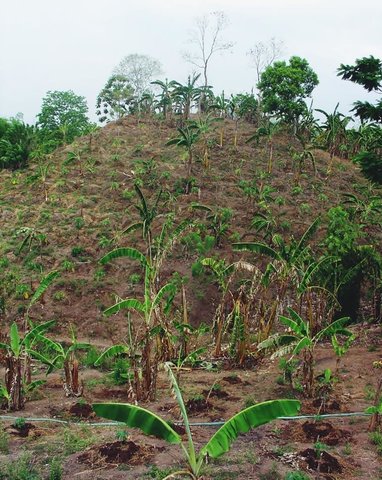
Soil Conservation Guided Farm System [ប្រទេសហ្វីលីពីន]
Soil Conservation Guided Farming System (SCGFS) is a land use management approach that integrates technologies: terracing, agro-pastoral technology, multi-storey cropping, and contouring within the socio-economic and bio-physical limitations of upland areas for optimum development of soil and water resource in a sustainable manner.
- អ្នកចងក្រង៖ Philippine Overview of Conservation Approaches and Technologies
2. ការពណ៌នាពីបច្ចេកទេស SLM
2.1 ការពណ៌នាដោយសង្ខេបពីបច្ចេកទេស
និយមន័យបច្ចេកទេស:
It is a farming system that integrates the growing of fodder crops under plantation crops.
2.2 ការពណ៌នាលម្អិតពីបច្ចេកទេស
ការពណ៌នា:
It is an integration of livestock and agronomic crop production of incorporating small ruminants in an existing citrus plantation. This technology was based on the private initiative of the farmer where he adapted it from other land users. He further improved it through study of reading materials and ad hoc monitoring of his environment.
Purpose of the Technology: After the adaption of the technology, the land user observed a decrease in the infestation of aphids. The land user observed and concluded that the decline in the aphids infestation was due to the presence of the small ruminants in the area. The small ruminants forage on grasses that were continuously growing, year-round, in the plantation area. The foraging of grasses improved the micro-environment of the plantation crop, which contributed to the decline and almost total eradication of aphids in the area, as observed by the land user. This promoted natural farming and improved the biodiversity.
Establishment / maintenance activities and inputs: The area was first established as a citrus plantation inter-cropped with Vigna unguiculata, Cucurbita maxima, and Ipomoea batatas, as cash crop during the vegetative stage of the citrus crop. As the small ruminants increased in number, the land user decided to do “controlled grazing” by dividing the area into 3 paddocks. During lean days of forage grasses, the land user practices “cut-and-carry” system of feeding. In addition, the manure of the small ruminants serves as a source of organic fertilizer for the citrus and other crops grown by the land user.
Natural / human environment: Aside from the eradication of the aphids on the citrus crop, the technology aided in the financial needs of the land user. It increased the land user’s income by an increase in the fruits bore by the crop and the increase in the number of the small ruminants. The land user sells or sometimes suppliers of citrus fruit and goat meat would go to the area to do wholesale buying. As for the community near the area, they to benefit from the area, by wholesale buying the citrus fruit and be the one selling it to the market. The technology does not only contribute to the livelihood improvement of the land user but also to the community.
2.3 រូបភាពនៃបច្ចេកទេស
2.5 ប្រទេស/តំបន់/ទីតាំងកន្លែង ដែលបច្ចេកទេសត្រូវបានអនុវត្ត និងបានគ្រប់ដណ្តប់ដោយការវាយតម្លៃនេះ
ប្រទេស:
ប្រទេសហ្វីលីពីន
តំបន់/រដ្ឋ/ខេត្ត:
Bulacan
បញ្ជាក់បន្ថែមពីលក្ខណៈនៃទីតាំង:
City of San Jose Del Monte
Map
×2.6 កាលបរិច្ឆេទនៃការអនុវត្ត
ប្រសិនបើមិនច្បាស់ឆ្នាំ សូមបញ្ជាក់កាលបរិច្ឆេទដែលប្រហាក់ប្រហែល:
- តិចជាង 10ឆ្នាំមុន (ថ្មី)
2.7 ការណែនាំពីបច្ចេកទេស
សូមបញ្ជាក់តើបច្ចេកទេសត្រូវបានណែនាំឱ្យអនុវត្តដោយរបៀបណា:
- តាមរយៈការបង្កើតថ្មីរបស់អ្នកប្រើប្រាស់ដី
- experience from other farm land user
មតិយោបល់ (ប្រភេទនៃគម្រោង ។ល។):
8 years
3. ចំណាត់ថ្នាក់នៃបច្ចេកទេស SLM
3.2 ប្រភេទដីប្រើប្រាស់មួយប្រភេទ (ច្រើនប្រភេទ) ដែលបានអនុវត្តបច្ចេកទេស

ដីដាំដំណាំ
- ដំណាំរយៈពេលវែង (មិនមែនឈើ)
ដំណាំចម្បង (ដំណាំកសិ-ឧស្សាហកម្ម និងដំណាំស្បៀង) :
Major cash crop:
Citrus
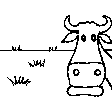
ដីសម្រាប់ចិញ្ចឹមសត្វ
- Silvo-pastoralism
ប្រភេទសត្វ និងផលិតផលចម្បងៗ:
Goat and sheep grazing in combination
មតិយោបល់:
Major land use problems (compiler’s opinion): Possibility of pollution in the area. The land user might have applied pesticide to the citrus crops to control the pest, but the land user did not mention of it. Application of herbicide to control the growth of grasses within and outside the area.
Major land use problems (land users’ perception): Without land conservation, there was an occurrence of pest in the citrus plants.
Mixed: (eg agro-pastoralism, silvo-pastoralism): silvo-pastoralism, goat and sheep grazing in combination
Future (final) land use (after implementation of SLM Technology): Mixed: Ms: Silvo-pastoralism
ប្រសិនបើដីមានការប្រែប្រួលបន្ទាប់ពីការអនុវត្តបច្ចេកទេស សូមបញ្ជាក់ពីការប្រើប្រាស់ដីមុនពេលអនុវត្តន៍បច្ចេកទេស:
Cropland: Cp: Perennial (non-woody) cropping
3.3 ព័ត៌មានបន្ថែមអំពីអ្នកប្រើប្រាស់ដី
ការផ្គត់ផ្គង់ទឹកនៅកន្លែងអនុវត្តបច្ចេកទេស:
- ទឹកភ្លៀង
មតិយោបល់:
Water supply: rainfed, rainfed
ចំនួនសារដែលដាំដំណាំក្នុងមួយឆ្នាំ:
- 1
សូមបញ្ជាក់:
Longest growing period in days: 120Longest growing period from month to month: July to November
ដង់ស៊ីតេនៃសត្វចិញ្ចឹម (បើពាក់ព័ន្ធ):
1-10 LU /km2
3.4 ក្រុម SLM ដែលបច្ចេកទេសស្ថិតនៅក្នុង
- ការគ្រប់គ្រងដោយរួមបញ្ចូលការដាំដំណាំ និងការចិញ្ចឹមសត្វ
- បញ្ចូលការគ្រប់គ្រងសត្វល្អិត និងជំងឺតាមបែបចម្រុះ (រួមទាំង កសិកម្មសរីរាង្គ)
3.5 ការសាយភាយនៃបច្ចេកទេស
បញ្ជាក់ពីការសាយភាយនៃបច្ចេកទេស:
- ត្រូវបានផ្សព្វផ្សាយត្រឹមតំបន់មួយ
ប្រសិនបើបច្ចេកទេសត្រូវបានសាយភាយពាសពេញតំបន់ណាមួយ សូមកំណត់ទំហំផ្ទៃដីអនុវត្តន៍:
- < 0.1 គម2 (10 ហិកតា)
មតិយោបល់:
Total area covered by the SLM Technology is 0.08 m2.
3.6 វិធានការ SLM ដែលបញ្ចូលនូវបច្ចេកទេស

វិធានការក្សេត្រសាស្ត្រ
- A1: ដំណាំ/គម្របដី

វិធានការរុក្ខជាតិ
- V2: ស្មៅនិងរុក្ខជាតិៗដែលដុះមានអាយុមិនលើសពី 2ឆ្នាំ
មតិយោបល់:
Main measures: agronomic measures
Secondary measures: vegetative measures
Type of agronomic measures: mixed cropping / intercropping, manure / compost / residues
Type of vegetative measures: scattered / dispersed
3.7 កំណត់ប្រភេទនៃការធ្លាក់ចុះគុណភាពដីសំខាន់ៗដែលបច្ចេកទេសនេះបានដោះស្រាយ

ការធ្លាក់ចុះជីវសាស្ត្រនៃដី
- Bp: ការកើនឡើងនូវសត្វល្អិត ឬជំងឺ បាត់បង់នូវសត្វមានប្រយោជន៍
មតិយោបល់:
Main type of degradation addressed: Bp: increase of pests / diseases, loss of predators
Main causes of degradation: crop management (annual, perennial, tree/shrub) (intercropping planting), droughts (time frame of drought)
Secondary causes of degradation: soil management (grazing of small ruminants), overgrazing (no. of small ruminants), change in temperature (dry season time frame)
3.8 ការពារ កាត់បន្ថយ ឬស្តារឡើងវិញនៃការធ្លាក់ចុះគុណភាពដី
បញ្ជាក់ពីគោលដៅរបស់បច្ចេកទេស ដែលផ្តោតទៅការធ្លាក់ចុះគុណភាពដី:
- ការកាត់បន្ថយការធ្លាក់ចុះគុណភាពដី
- ការជួសជុល/ ស្តារឡើងវិញនៃឱនភាពដីធ្ងន់ធ្ងរ
មតិយោបល់:
Main goals: mitigation / reduction of land degradation
Secondary goals: rehabilitation / reclamation of denuded land
Third goal: prevention of land degradation, rehabilitation
4. បច្ចេកទេសជាក់លាក់ សកម្មភាពអនុវត្ត ធាតុចូល និងថ្លៃដើម
4.1 គំនូសបច្ចេកទេសនៃបច្ចេកទេសនេះ
4.2 លក្ខណៈពិសេសនៃបច្ចេកទេស/ ពណ៌នាពីគំនូរបច្ចេកទេស
Citrus plants are evenly distributed in the area, with a planting distance of 8 feet by 8 feet. The ground cover are forage grasses for the small ruminants.
Location: Barangay San Roque. San Jose Del Monte, Bulacan
Date: 06/29/2016
Technical knowledge required for field staff / advisors: moderate (technical assistance from agricultural advisory from other aspect in land degradation)
Technical knowledge required for land users: high (land user is open minded with the technology introduced)
Main technical functions: improvement of ground cover, stabilisation of soil (eg by tree roots against land slides), increase in organic matter, increase in nutrient availability (supply, recycling,…), increase of biomass (quantity), promotion of vegetation species and varieties (quality, eg palatable fodder)
Secondary technical functions: control of raindrop splash, control of dispersed runoff: impede / retard, control of concentrated runoff: drain / divert, increase of surface roughness, increase of infiltration, reduction in wind speed, spatial arrangement and diversification of land use
Mixed cropping / intercropping
Material/ species: pole sitao-squash-sweet potato/citrus
Agronomic measure: intercropping (1st Year)
Material/ species: pole sitao/citrus
Quantity/ density: 2,000/188
Agronomic measure: intercropping (2nd year)
Material/ species: squash/ citrus
Quantity/ density: 2,000/188
Agronomic measure: intercropping (3rd year)
Material/ species: sweet potato/ citrus
Quantity/ density: 8,800/188
Manure / compost / residues
Material/ species: goat manure
Quantity/ density: 5,000 kg
Remarks: .5 per square meter
Scattered / dispersed
Vegetative material: G : grass
4.3 ព័ត៌មានទូទៅដែលពាក់ព័ន្ធនឹងការគណនាធាតុចូល និងថ្លៃដើម
ផ្សេងៗ/ រូបិយប័ណ្ណជាតិ (បញ្ជាក់):
Philippine Peso
កំណត់អត្រាប្តូរប្រាក់ពីដុល្លាទៅរូបិយប័ណ្ណតំបន់ (បើទាក់ទង)៖ 1 ដុល្លារ =:
47,5
កំណត់ថ្លៃឈ្នួលជាមធ្យមនៃការជួលកម្លាំងពលកម្មក្នុងមួយថ្ងៃ:
5.26
4.4 សកម្មភាពបង្កើត
| សកម្មភាព | ប្រភេទវិធានការ | ពេលវេលា | |
|---|---|---|---|
| 1. | rotational grazing | សារពើរុក្ខជាតិ | rainy season |
| 2. | cut-and-carry feeding system | សារពើរុក្ខជាតិ | dry season |
| 3. | Buying pole sitao | ក្សេត្រសាស្ត្រ | |
| 4. | Buying sqaush | ក្សេត្រសាស្ត្រ | |
| 5. | Buying citrus | ក្សេត្រសាស្ត្រ |
4.5 ថ្លៃដើម និងធាតុចូលដែលត្រូវការសម្រាប់ការបង្កើតបច្ចេកទេស
| បញ្ជាក់ពីធាតុចូល | ឯកតា | បរិមាណ | ថ្លៃដើមក្នុងមួយឯកតា | ថ្លៃធាតុចូលសរុប | % នៃថ្លៃដើមដែលចំណាយដោយអ្នកប្រើប្រាស់ដី | |
|---|---|---|---|---|---|---|
| កម្លាំងពលកម្ម | Labour | ha | 1,0 | 10,52 | 10,52 | 100,0 |
| សម្ភារៈដាំដុះ | Seeds | ha | 1,0 | 3160,0 | 3160,0 | 100,0 |
| សម្ភារៈដាំដុះ | Seedlings | ha | 1,0 | 48,0 | 48,0 | 100,0 |
| សម្ភារៈសាងសង់ | Hog wire | ha | 1,0 | 397,89 | 397,89 | 100,0 |
| ថ្លៃដើមសរុបក្នុងការបង្កើតបច្ចេកទេស | 3616,41 | |||||
មតិយោបល់:
Duration of establishment phase: 12 month(s)
Life span of products:
Pole Sitao - 1 year
Squash - 1 year
Citrus - 50 years
4.7 កំណត់ថ្លៃដើមសម្រាប់ការថែទាំ/ សកម្មភាពរបស់បច្ចេកទេស (ក្នុងរយៈពេលមួយឆ្នាំ)
| បញ្ជាក់ពីធាតុចូល | ឯកតា | បរិមាណ | ថ្លៃដើមក្នុងមួយឯកតា | ថ្លៃធាតុចូលសរុប | % នៃថ្លៃដើមដែលចំណាយដោយអ្នកប្រើប្រាស់ដី | |
|---|---|---|---|---|---|---|
| កម្លាំងពលកម្ម | Labour | ha | 1,0 | 10,52 | 10,52 | 100,0 |
| ថ្លៃដើមសរុបសម្រាប់ការថែទាំដំណាំតាមបច្ចេកទេស | 10,52 | |||||
មតិយោបល់:
The above costs usually occurs during the dry season when forage grasses are scarce. Lean months of availability of forages grasses are from the months April to June. This is the time the cut-and-carry method is applied and the start of the maintenance/recurrent cost.
4.8 កត្តាសំខាន់បំផុតដែលមានឥទ្ធិពលដល់ការចំណាយ
ពណ៌នាពីកត្តាប៉ះពាល់ចម្បងៗទៅលើថ្លៃដើម:
Cut-and-carry method of feeding the small ruminants during lean months of forage grasses.
5. លក្ខណៈបរិស្ថានធម្មជាតិ និងមនុស្ស
5.1 អាកាសធាតុ
បរិមាណទឹកភ្លៀងប្រចាំឆ្នាំ
- < 250 មម
- 251-500 មម
- 501-750 មម
- 751-1,000 មម
- 1,001-1,500 មម
- 1,501-2,000 មម
- 2,001-3,000 មម
- 3,001-4,000 មម
- > 4,000 មម
កំណត់បរិមាណទឹកភ្លៀង (បើដឹង) ជា មីលីម៉ែត្រ:
2382,00
តំបន់កសិអាកាសធាតុ
- មានភ្លៀងមធ្យម
Thermal climate class: tropics
5.2 សណ្ឋានដី
ជម្រាលជាមធ្យម:
- រាបស្មើ (0-2%)
- ជម្រាលតិចតួច (3-5%)
- មធ្យម (6-10%)
- ជម្រាលខ្ពស់បន្តិច (11-15%)
- ទីទួល (16-30%)
- ទីទួលចោត (31-60%)
- ទីទួលចោតខ្លាំង (>60%)
ទម្រង់ដី:
- ខ្ពង់រាប
- កំពូលភ្នំ
- ជម្រាលភ្នំ
- ជម្រាលទួល
- ជម្រាលជើងភ្នំ
- បាតជ្រលងភ្នំ
តំបន់តាមរយៈកម្ពស់ :
- 0-100 ម
- 101-500 ម
- 501-1,000 ម
- 1,001-1,500 ម
- 1,501-2,000 ម
- 2,001-2,500 ម
- 2,501-3,000 ម
- 3,001-4,000 ម
- > 4,000 ម
បញ្ជាក់ថាតើបច្ចេកទេសនេះត្រូវបានអនុវត្តន៍នៅក្នុង:
- សណ្ឋានដីផត
មតិយោបល់ និងបញ្ចាក់បន្ថែមអំពីសណ្ឋានដី :
Landforms: Ridges (concave)
5.3 ដី
ជម្រៅដីជាមធ្យម:
- រាក់ខ្លាំង (0-20 សម)
- រាក់ (21-50 សម)
- មធ្យម (51-80 សម)
- ជ្រៅ (81-120 សម)
- ជ្រៅខ្លាំង (> 120 សម)
វាយនភាពដី (ស្រទាប់លើ):
- មធ្យម (ល្បាយ, ល្បាប់)
សារធាតុសរីរាង្គនៅស្រទាប់ដីខាងលើ:
- មធ្យម (1-3%)
បើអាចសូមភ្ជាប់ការពណ៌នាពីដីឱ្យបានច្បាស់ ឬព័ត៌មានដែលអាចទទួលបាន ឧ. ប្រភេទដី, pH ដី/ ជាតិអាស៊ីត, សមត្ថភាពផ្លាស់ប្តូរកាចុង, វត្តមាននីត្រូសែន, ភាពប្រៃ ។ល។:
Soil fertility is: Medium
Soil drainage/infiltration is: Good
Soil water storage is: High
5.4 ទឹកដែលអាចទាញមកប្រើប្រាស់បាន និងគុណភាពទឹក
ទឹកលើដីដែលអាចទាញយកប្រើប្រាស់បាន:
ល្អ
គុណភាពទឹក (មិនបានធ្វើប្រត្តិកម្ម):
ទឹកសម្រាប់តែការធ្វើកសិកម្ម (ស្រោចស្រព)
5.5 ជីវៈចម្រុះ
ភាពសម្បូរបែបនៃប្រភេទ:
- កម្រិតមធ្យម
5.6 លក្ខណៈនៃអ្នកប្រើប្រាស់ដីដែលអនុវត្តបច្ចេកទេស
ទីផ្សារនៃប្រព័ន្ធផលិតកម្ម:
- សម្រាប់ហូបក្នុងគ្រួសារ (ផ្គត់ផ្គង់ខ្លួនឯង)
- ពាក់កណ្តាលពាណិជ្ជកម្ម (ផ្គត់ផ្គង់ខ្លួនឯង/ ពាណិជ្ជកម្ម
ចំណូលក្រៅកសិកម្ម:
- 10-50% នៃចំណូល
កម្រិតជីវភាព:
- មធ្យម
ឯកជន ឬក្រុម:
- ធ្វើខ្លួនឯង/ គ្រួសារ
កម្រិតប្រើប្រាស់គ្រឿងយន្ត:
- ប្រើកម្លាំងពលកម្ម
យេនឌ័រ:
- បុរស
សូមបញ្ជាក់ពីលក្ខណៈពាក់ព័ន្ធផ្សេងទៀតអំពីអ្នកប្រើប្រាស់ដី:
Land users applying the Technology are mainly common / average land users
Difference in the involvement of women and men: It is the countries socio-cultural model, where men is the one working and the women stay at home. According to the land user it is the women who is record keeper.
Population density: 10-50 persons/km2
Annual population growth: 0.5% - 1%
10% of the land users are average wealthy.
Off-farm income specification: off-farm income provides additional income to the land user during the dry season.
Market orientation: Subsistence (small ruminants are bought by the land user)
5.7 ទំហំផ្ទៃដីជាមធ្យមនៃដីផ្ទាល់ខ្លួន ឬជួលគេដែលបានអនុវត្តបច្ចេកទេស
- < 0.5 ហិកតា
- 0.5-1 ហិកតា
- 1-2 ហិកតា
- 2-5 ហិកតា
- 5-15 ហិកតា
- 15-50 ហិកតា
- 50-100 ហិកតា
- 100-500 ហិកតា
- 500-1,000 ហិកតា
- 1,000-10,000 ហិកតា
- > 10,000 ហិកតា
តើផ្ទៃដីនេះចាត់ទុកជាទំហំកម្រិតណាដែរ ខ្នាតតូច មធ្យម ឬខ្នាតធំ (ធៀបនឹងបរិបទតំបន់)?
- ខ្នាតតូច
មតិយោបល់:
Average area of land owned or leased by land users applying the Technology: < 0.5 ha, < 0.5 ha, 0.5-1 ha, 1-2 ha
5.8 ភាពជាម្ចាស់ដី កម្មសិទ្ធប្រើប្រាស់ដី និងកម្មសិទ្ធប្រើប្រាស់ទឹក
ភាពជាម្ចាស់ដី:
- ឯកជន មានកម្មសិទ្ធ
កម្មសិទ្ធិប្រើប្រាស់ដី:
- ឯកជន
កម្មសិទ្ធប្រើប្រាស់ទឹក:
- ជាក្រុម (មានដែនកំណត់)
5.9 ការប្រើប្រាស់សេវាកម្ម និងហេដ្ឋារចនាសម្ព័ន្ធ
សុខភាព:
- មិនល្អ
- មធ្យម
- ល្អ
ការអប់រំ:
- មិនល្អ
- មធ្យម
- ល្អ
ជំនួយបច្ចេកទេស:
- មិនល្អ
- មធ្យម
- ល្អ
ការងារ (ឧ. ការងារក្រៅកសិដ្ឋាន):
- មិនល្អ
- មធ្យម
- ល្អ
ទីផ្សារ:
- មិនល្អ
- មធ្យម
- ល្អ
ថាមពល:
- មិនល្អ
- មធ្យម
- ល្អ
ផ្លូវ និងការដឹកជញ្ជូន:
- មិនល្អ
- មធ្យម
- ល្អ
ទឹកផឹក និងអនាម័យ:
- មិនល្អ
- មធ្យម
- ល្អ
សេវាកម្មហិរញ្ញវត្ថុ:
- មិនល្អ
- មធ្យម
- ល្អ
6. ផលប៉ះពាល់ និងការសន្និដ្ឋាន
6.1 ផលប៉ះពាល់ក្នុងបរិវេណអនុវត្តបច្ចេកទេសដែលកើតមាន
ផលប៉ះពាល់លើសេដ្ឋកិច្ចសង្គម
ផលិតផល
ផលិតកម្មដំណាំ
គុណភាពមុន SLM:
3,000 kilograms
គុណភាពក្រោយ SLM:
8,000 kilograms
ផលិតកម្មសត្វ
គុណភាពមុន SLM:
5
គុណភាពក្រោយ SLM:
5
ភាពសម្បូរបែបនៃផលិតផល
ការគ្រប់គ្រងដី
ចំណូល និងថ្លៃដើម
ចំណូលក្នុងកសិដ្ឋាន
គុណភាពមុន SLM:
30,000
គុណភាពក្រោយ SLM:
80,000
ភាពសម្បូរបែបប្រភពប្រាក់ចំណូល
បន្ទុកការងារ
ផលប៉ះពាល់ទៅលើសេដ្ឋកិច្ចសង្គមផ្សេងៗ
Improved livelihoods and human well-being
មតិយោបល់/ ការបញ្ជាក់:
It gave an opportunity to the neighbors of the land user to work at the field, with pay. Thus, an added income to the neighbor of the land user. According to the land user, he was able to send his children to a decent school for a quality education. It also gave the land user another source of income by purchasing a jeepney used as a public transportation through the increased income from the SLM technogy he adapted.
ផលប៉ះពាល់ទៅលើវប្បធម៌សង្គម
សន្តិសុខស្បៀង/ ភាពគ្រប់គ្រាន់ខ្លួនឯង
មតិយោបល់/ ការបញ្ជាក់:
The increased in the income of the land user contributes to the food security of the family
ស្ថានភាពសុខភាព
មតិយោបល់/ ការបញ្ជាក់:
Daily chores of herding the small ruminants contributes to the good over health of the land user
ចំណេះដឹង SLM / ការធ្លាក់ចុះគុណភាពដី
មតិយោបល់/ ការបញ្ជាក់:
Rotational grazing and "cut-and-carry" style of feeding contributed to the possible overgrazing which is contributor to erosion
ការកាត់បន្ថយជម្លោះ
ស្ថានភាពក្រុមដែលមានបញ្ហាក្នុងសង្គម និងសេដ្ឋកិច្ច
មតិយោបល់/ ការបញ្ជាក់:
The land user allows the member of his community to harvest some fruits and sell them to the market without the land user asking for something in return.
ផលប៉ះពាល់ទៅលើអេកូឡូស៊ី
វដ្តទឹក/លំហូរ
បរិមាណទឹក
គុណភាពទឹក
លំហូរទឹកលើផ្ទៃដី
មតិយោបល់/ ការបញ្ជាក់:
Rotational grazing and "cut-and carry" style of feeding contributes to the reduction in surface runoff, grasses are maintained on the soil surface
ប្រព័ន្ធបង្ហូរទឹក
នីវ៉ូទឹកក្រោមដី/ ដង្ហើមទឹក
រំហួត
ដី
សំណើមដី
គម្របដី
មតិយោបល់/ ការបញ្ជាក់:
Maintenance of grasses on the soil surface
ការបាត់បង់ដី
មតិយោបល់/ ការបញ្ជាក់:
Maintenance of grasses on the soil surface reduced soil in any form
ដីប្រេះ
ដីហាប់
វដ្តនៃសារធាតុចិញ្ចឹម/ការទទួលបាន
មតិយោបល់/ ការបញ្ជាក់:
Manure of the small ruminants contributes to nutrient recycling
ភាពប្រៃ
សារធាតុសរីរាង្គដី/ការបូនក្រោមដី
មតិយោបល់/ ការបញ្ជាក់:
Manure of the small ruminants contributes to the increased in soil organic matter content
ជីវចម្រុះ៖ ដំណាំ, សត្វ
ប្រភេទរាតត្បាត
មតិយោបល់/ ការបញ្ជាក់:
Incorporation of small ruminants in the farming system which aid in the maintenance of grasses within the plantation area, helps improve the microclimatic condition inside the plantation area that further reduced alien species invasion
ការគ្រប់គ្រងកត្តាចង្រៃ/ ជំងឺ
មតិយោបល់/ ការបញ្ជាក់:
Incorporation of small ruminants in the farming system which aid in the maintenance of grasses within the plantation area, helps improve the microclimatic condition inside the plantation area that further increased biological pest/disease control
ការកាត់បន្ថយហានិភ័យនៃគ្រោះមហន្តរាយ និងគ្រោះអាកាសធាតុ
ហានិភ័យនៃភ្លើងឆេះព្រៃ
ល្បឿនខ្យល់
6.2 ផលប៉ះពាល់ក្រៅបរិវេណអនុវត្តបច្ចេកទេសដែលកើតមាន
ទឹកជំនន់ខ្សែទឹកខាងក្រោម
មតិយោបល់/ ការបញ្ជាក់:
Maintenance of grasses on the soil surface improves soil tilth which further improves infiltration capacity
Buffering/សមត្ថភាពចម្រោះ
មតិយោបល់/ ការបញ្ជាក់:
Manure of the small ruminants improves the soil tilth, an improved soil tilth improves the buffering/filtering capacity of the soil
ខ្យល់នាំយកនូវធូរលី
មតិយោបល់/ ការបញ្ជាក់:
Maintenance of grasses on the soil surface reduces erosion due to wind
6.3 ភាពប្រឈម និងភាពរួសនៃបច្ចេកទេសទៅនឹងការប្រែប្រួលអាកាសធាតុ និងគ្រោះអាកាសធាតុ/ គ្រោះមហន្តរាយ (ដែលដឹងដោយអ្នកប្រើប្រាស់ដី)
ការប្រែប្រួលអាកាសធាតុ
ការប្រែប្រួលអាកាសធាតុ
| រដូវកាល | ប្រភេទនៃការប្រែប្រួលអាកាសធាតុ/ព្រឹត្តិការណ៍ | លក្ខណៈឆ្លើយតបនៃបច្ចេកទេសទៅនឹងការប្រែប្រួលអាកាសធាតុ | |
|---|---|---|---|
| សីតុណ្ហភាពប្រចាំឆ្នាំ | កើនឡើង | មិនស្គាល់ |
គ្រោះអាកាសធាតុ (មហន្តរាយ)
គ្រោះមហន្តរាយធម្មជាតិ
| លក្ខណៈឆ្លើយតបនៃបច្ចេកទេសទៅនឹងការប្រែប្រួលអាកាសធាតុ | |
|---|---|
| ព្យុះភ្លៀងតាមតំបន់ | មិនស្គាល់ |
| ព្យុះកំបុតត្បូងតាមតំបន់ | មិនស្គាល់ |
គ្រោះមហន្តរាយអាកាសធាតុ
| លក្ខណៈឆ្លើយតបនៃបច្ចេកទេសទៅនឹងការប្រែប្រួលអាកាសធាតុ | |
|---|---|
| រាំងស្ងួត | មិនល្អ |
គ្រោះមហន្តរាយទឹក
| លក្ខណៈឆ្លើយតបនៃបច្ចេកទេសទៅនឹងការប្រែប្រួលអាកាសធាតុ | |
|---|---|
| ទឹកជំនន់ទូទៅ (ទន្លេ) | មិនស្គាល់ |
ផលវិបាកដែលទាក់ទងនឹងបរិយាកាសផ្សេងៗទៀត
ផលវិបាកដែលទាក់ទងនឹងបរិយាកាសផ្សេងៗទៀត
| លក្ខណៈឆ្លើយតបនៃបច្ចេកទេសទៅនឹងការប្រែប្រួលអាកាសធាតុ | |
|---|---|
| កាត់បន្ថយពេលដាំដុះ | មិនស្គាល់ |
6.4 ការវិភាគថ្លៃដើម និងអត្ថប្រយោជន៍
តើផលចំណេញ និងថ្លៃដើមត្រូវបានប្រៀបធៀបគ្នាយ៉ាងដូចម្តេច (ទស្សនៈរបស់អ្នកប្រើប្រាស់ដី)?
រយៈពេលខ្លី:
វិជ្ជមាន
រយៈពេលវែង:
វិជ្ជមានខ្លាំង
តើផលចំណេញ និងការថែទាំ/ ជួសជុលត្រូវបានប្រៀបធៀបគ្នាយ៉ាងដូចម្តេច (ទស្សនៈរបស់អ្នកប្រើប្រាស់ដី)?
រយៈពេលខ្លី:
វិជ្ជមាន
រយៈពេលវែង:
វិជ្ជមានខ្លាំង
6.5 ការទទួលយកបច្ចេកទេស
ក្នុងចំណោមគ្រួសារទាំងអស់ដែលអនុវត្តបច្ចេកទេស តើមានប៉ុន្មានគ្រួសារដែលចង់ធ្វើដោយខ្លួនឯង ដោយមិនទទួលបានសម្ភារៈលើកទឹកចិត្ត/ប្រាក់ឧបត្ថម្ភ?:
- 90-100%
មតិយោបល់:
100% of land user families have adopted the Technology without any external material support
1 land user families have adopted the Technology without any external material support
There is no trend towards spontaneous adoption of the Technology
6.7 ភាពខ្លាំង/ គុណសម្បត្តិ/ ឱកាសនៃបច្ចេកទេស
| ភាពខ្លាំង/ គុណសម្បត្តិ/ ឱកាសនៅកន្លែងរបស់អ្នកប្រើប្រាស់ដី |
|---|
| Decreased in occurrence of pest |
| Increased land user's income |
| Helped the land user's neighbor by profit sharing during harvest of the citrus fruits |
| ភាពខ្លាំង/ គុណសម្បត្តិ/ ឱកាស ទស្សនៈរបស់បុគ្គលសំខាន់ៗ |
|---|
|
Less labor input How can they be sustained / enhanced? Improve the varietal species of the forage grass |
|
Decreased in occurrence of pest How can they be sustained / enhanced? Maintain the existing micro environment |
| Rotational grazing |
6.8 ភាពខ្សោយ/ គុណវិបត្តិ/ ហានិភ័យនៃបច្ចេកទេស និងវិធីសាស្ត្រដោះស្រាយ
| ភាពខ្សោយ/ គុណវិបត្តិ/ ហានិភ័យ ទស្សនៈរបស់អ្នកប្រើប្រាស់ដី | តើបច្ចេកទេសទាំងនោះបានដោះស្រាយបញ្ហាដូចម្តេច? |
|---|---|
| There was an inbreeding of the small ruminants | Putting another small ruminants of good genetic quality |
| ភាពខ្សោយ/ គុណវិបត្តិ/ ហានិភ័យ ទស្សនៈរបស់អ្នកចងក្រងឬបុគ្គលសំខាន់ៗ | តើបច្ចេកទេសទាំងនោះបានដោះស្រាយបញ្ហាដូចម្តេច? |
|---|---|
| Variety of forage grass is of low quality in terms of crude protein content | Planting of improved variety with a high crude protein content |
| Species of small ruminants are not of good genetic quality in terms of meat quality | Putting of species with a good genetic quality in terms of meat produce |
ការតភ្ជាប់ និងម៉ូឌុល
ពង្រីកមើលទាំងអស់ បង្រួមទាំងអស់ការតភ្ជាប់

Soil Conservation Guided Farm System [ប្រទេសហ្វីលីពីន]
Soil Conservation Guided Farming System (SCGFS) is a land use management approach that integrates technologies: terracing, agro-pastoral technology, multi-storey cropping, and contouring within the socio-economic and bio-physical limitations of upland areas for optimum development of soil and water resource in a sustainable manner.
- អ្នកចងក្រង៖ Philippine Overview of Conservation Approaches and Technologies
ម៉ូឌុល
គ្មានម៉ូឌុល


